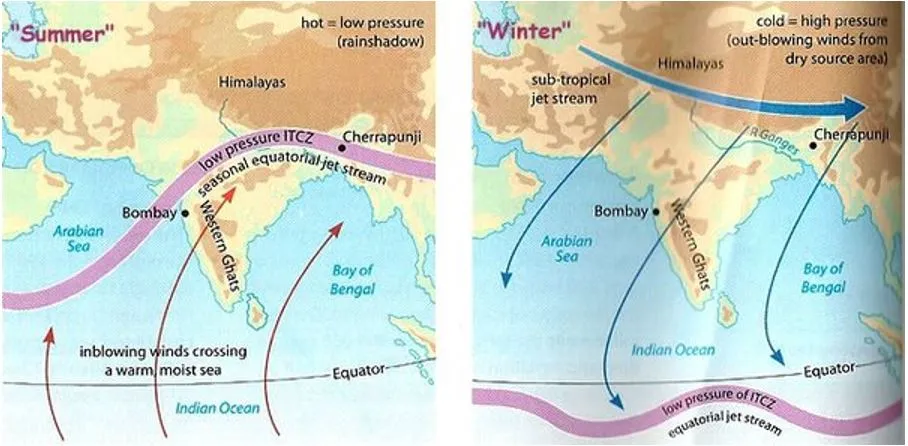

10th September 2024 (12 Topics)
Context
The Indian Ocean's unique climatic and oceanographic features, along with its role in cyclogenesis, have recently gained attention due to the rare August cyclone named ‘Asna’. This cyclone is noteworthy as it marks the first instance of a North Indian Ocean cyclone in August since 1981, reflecting unusual patterns in cyclogenesis and monsoonal behavior.
Monsoonal Circulation in the Indian Ocean
The Indian Ocean plays a crucial role in the summer monsoon, which is vital for replenishing water resources across the Indian subcontinent. Below is how the monsoonal circulation operates:
- Evaporation and Moisture Supply: The North Indian Ocean contributes significantly to the monsoon by supplying moisture. Warm sea surfaces in the Arabian Sea and the Bay of Bengal facilitate high evaporation rates, which are crucial for generating the moisture needed for the monsoon rains.
- Cyclogenesis: Cyclones, which are intense weather systems, form in warm tropical waters where high evaporation rates provide the necessary energy. The North Indian Ocean is unique due to its seasonal cyclogenesis patterns: cyclones typically form during the-
- pre-monsoon (April to June)
- post-monsoon (October to December) periods
- Regional Variations: The Arabian Sea and the Bay of Bengal exhibit different cyclogenesis patterns.
- The Arabian Sea, though warm, shows relatively less cyclonic activity due to cooler temperatures, weaker convective activity, and stronger wind shear during the monsoon.
- In contrast, the Bay of Bengal is more active with numerous cyclones due to favorable conditions for convection and cyclogenesis.
Why the Pattern is Changing Now?
Recent changes in cyclone patterns and monsoonal behavior can be attributed to several factors:
- Climate Change: The Indian Ocean is warming rapidly, driven by increased heat inflows from the Pacific and Southern Oceans. This warming trend is altering traditional cyclone patterns and affecting the monsoon. Elevated sea surface temperatures (SSTs) in the Indian Ocean enhance cyclogenesis but can also lead to more unpredictable weather patterns.
- Atmospheric Changes: Changes in atmospheric circulation, including variations in wind patterns and humidity levels, influence cyclone formation. The Indian Ocean's rapid warming is impacting global atmospheric circulation, affecting weather patterns across the region.
- Oceanic Inputs: The Indian Ocean is influenced by ‘oceanic tunnels’—warm water inflows from the Pacific and cooler waters from the Southern Ocean. These inputs contribute to regional sea surface temperature variations and influence cyclonic activity.
What is Surprising: The August Cyclone 'Asna'?
- Rare Timing: The formation of cyclone ‘Asna’ in August is unusual. Historically, the North Indian Ocean typically experiences cyclones during the pre-monsoon and post-monsoon seasons. The emergence of a cyclone in August signifies a deviation from these established patterns.
- Land-to-Ocean Transition: ‘Asna’ began as a powerful land-born depression that intensified over the Arabian Sea. This transition from a land-based system to an oceanic cyclone is rare and underscores the changing dynamics of cyclogenesis in the Indian Ocean.
- Implications of Warming: The unusual growth of ‘Asna’ over the Arabian Sea, which was energized by warm waters, highlights the broader impacts of climate change. The warming of the Arabian Sea and shifts in atmospheric conditions have allowed for unexpected cyclone developments and intensified weather events.



